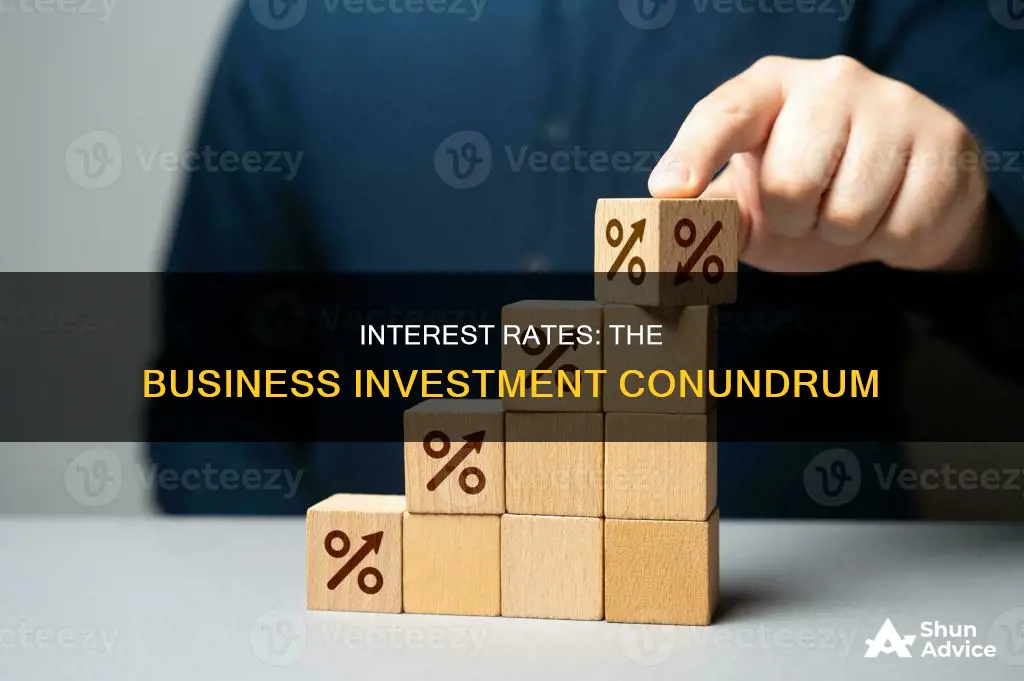
Interest rates play a pivotal role in shaping the investment decisions of businessmen. When interest rates are low, borrowing becomes cheaper, encouraging businessmen to invest in projects that require substantial capital. This can stimulate economic growth and business expansion. Conversely, high-interest rates may deter investment as borrowing becomes more expensive, potentially leading to reduced spending and slower economic development. Understanding the relationship between interest rates and investment is crucial for businessmen to make informed financial decisions and navigate the ever-changing economic landscape effectively.
What You'll Learn
- Interest Rate Sensitivity: Business investments are highly sensitive to changes in interest rates
- Cost of Capital: Higher interest rates increase the cost of capital, affecting investment decisions
- Return on Investment: Interest rates impact the expected return on investment, influencing business choices
- Debt vs. Equity: Interest rates influence the choice between debt and equity financing for investments
- Market Timing: Interest rate changes prompt businesses to adjust investment timing and strategies

Interest Rate Sensitivity: Business investments are highly sensitive to changes in interest rates
Interest rate sensitivity is a critical aspect of business investment decisions, as it directly impacts the cost of capital and the overall financial health of a company. When interest rates rise, the cost of borrowing increases, which can significantly affect a business's investment choices. This sensitivity is particularly evident in the corporate world, where even small changes in interest rates can have a substantial impact on investment strategies.
Businesses often rely on external financing to fund their operations and expansion plans. When interest rates are low, borrowing becomes cheaper, encouraging companies to invest in new projects, equipment, or expansion. This is because lower interest rates reduce the cost of debt, making it more attractive to finance long-term investments. For instance, a company might choose to invest in a new manufacturing plant or technology upgrade when interest rates are favorable, as the debt-servicing costs will be manageable.
However, the opposite is true when interest rates rise. Higher interest rates make borrowing more expensive, which can lead to a shift in investment strategies. In this scenario, businesses might become more cautious and reevaluate their investment plans. Some may opt to delay investments or seek alternative financing options, such as equity financing, to avoid the higher costs associated with debt. This sensitivity to interest rate changes can influence the timing and scale of business investments.
The impact of interest rates on investment decisions is particularly notable in sectors like real estate and construction. These industries often rely on long-term financing, and changes in interest rates can affect the affordability of loans. For example, a real estate developer might decide to postpone a new project if interest rates rise, as the higher borrowing costs could make the project financially unviable. Similarly, construction companies may reduce their investment in new projects during periods of high-interest rates.
In summary, interest rate sensitivity is a crucial factor in business investment decisions. Fluctuations in interest rates can influence the cost of capital, the timing of investments, and the overall financial strategy of a company. Businesses must carefully consider the potential impact of interest rate changes to make informed decisions and ensure the sustainability of their investment portfolios. Understanding this sensitivity is essential for businessmen to navigate the complex financial landscape and make strategic choices.
Unlocking the Bond: How Investment and Interest Rates Dance Together
You may want to see also

Cost of Capital: Higher interest rates increase the cost of capital, affecting investment decisions
The relationship between interest rates and investment decisions is a critical aspect of financial management for businesses. When interest rates rise, it has a direct impact on the cost of capital, which in turn influences a company's investment strategies. Higher interest rates mean that borrowing becomes more expensive, as lenders demand a higher return on their loans. This increased cost of capital can significantly affect a businessman's decision-making process.
For businesses, the cost of capital refers to the total cost of all the funds used to finance operations and investments. This includes debt financing, such as bank loans and bonds, as well as equity financing from shareholders. When interest rates rise, the cost of debt financing increases, as the interest payments on loans become more substantial. As a result, businesses may find it more expensive to fund their operations and expansion plans.
In response to higher interest rates, businessmen often need to reevaluate their investment strategies. One approach is to delay or reduce investments in new projects, as the cost of capital has increased. This can lead to a more conservative investment outlook, where companies might prioritize debt reduction and maintaining a strong balance sheet. By reducing the reliance on external borrowing, businesses can mitigate the impact of higher interest rates on their profitability.
Additionally, higher interest rates may encourage businessmen to seek alternative financing options. This could involve exploring the capital markets for long-term debt or equity financing, which might offer more favorable terms compared to traditional bank loans. Some companies may also consider internal funding sources, such as retained earnings, to minimize the exposure to external interest rates.
In summary, rising interest rates have a profound effect on the cost of capital, which is a critical factor in a businessman's investment decisions. Higher interest rates increase the cost of borrowing, prompting businesses to reconsider their investment strategies. This may result in more cautious approaches, such as debt reduction and exploring alternative financing methods, to ensure financial stability and mitigate the impact of higher interest rates on overall profitability. Understanding these dynamics is essential for effective financial management and strategic planning in a changing economic environment.
Navigating Fixed-Rate Investments: Understanding the Impact of Rising Interest Rates
You may want to see also

Return on Investment: Interest rates impact the expected return on investment, influencing business choices
Interest rates play a pivotal role in shaping the investment landscape for businessmen, significantly impacting their decisions and strategies. When it comes to Return on Investment (ROI), interest rates are a critical factor that can either boost or hinder a business's financial performance. Here's a detailed exploration of this relationship:
Understanding the Interest Rate-ROI Connection:
Interest rates directly influence the cost of borrowing for businesses. When interest rates are low, borrowing becomes cheaper, encouraging businesses to invest in expansion, new projects, or acquiring assets. This is because lower interest rates mean reduced financial burden on the business, allowing them to allocate more capital towards growth initiatives. As a result, businesses might invest in various opportunities, expecting higher returns to offset the lower borrowing costs. On the other hand, high-interest rates make borrowing more expensive, potentially discouraging new investments as the cost of capital increases.
Impact on Investment Decisions:
- Risk Assessment: Interest rates affect the risk-reward dynamics of investments. During periods of low interest rates, businesses might take on more financial risk, expecting higher returns to justify the additional costs. Conversely, high-interest rates may prompt a more cautious approach, favoring safer investments with lower potential returns.
- Time Horizon: Interest rates also influence the time horizon of investments. Short-term investments might be more attractive when interest rates are low, as the potential for quick returns can offset the lower interest income. In contrast, long-term investments may be preferred during periods of high interest rates, where the compounded returns over time can outweigh the higher borrowing costs.
- Alternative Investment Options: Interest rates can drive businesses to explore alternative investment avenues. For instance, when interest rates are low, businesses might shift their focus towards equity investments or venture capital, seeking higher returns in the stock market. Conversely, high-interest rates may encourage more traditional investment avenues like real estate or fixed-income securities.
Strategic Considerations:
Businessmen must carefully analyze the impact of interest rates on their specific industry and business model. For instance, industries heavily reliant on borrowing, such as construction or automotive, might be more sensitive to interest rate changes. A business owner in the construction sector, for instance, might need to consider how interest rate fluctuations affect the cost of materials and labor, ultimately influencing the profitability of their projects.
In summary, interest rates are a critical determinant of the investment landscape for businessmen, impacting their ROI expectations and overall financial strategies. Understanding these dynamics is essential for making informed investment decisions, ensuring that businesses can navigate the ever-changing economic environment effectively.
Interest Groups' Financial Investment in Political Candidates: A Deep Dive
You may want to see also

Debt vs. Equity: Interest rates influence the choice between debt and equity financing for investments
Interest rates play a pivotal role in the investment decisions of businessmen, particularly when it comes to choosing between debt and equity financing. This decision is crucial as it directly impacts the financial health and growth of a business. When interest rates are low, businesses often lean towards debt financing. This is because borrowing at lower rates can provide a competitive advantage, allowing companies to invest in expansion, research, and development, or to take advantage of market opportunities. Lower interest rates mean that the cost of borrowing is reduced, and the business can allocate more capital towards its core operations or strategic initiatives. This can lead to increased productivity, market share, and ultimately, higher profits.
On the other hand, high-interest rates can make debt financing more expensive and less attractive. In such scenarios, businessmen might opt for equity financing instead. Equity financing involves raising capital by selling a portion of ownership in the company to investors. While this approach dilutes the business owner's control, it provides a long-term solution to funding growth without the burden of interest payments. High-interest rates can also discourage new investments, as the cost of borrowing becomes too high, making it challenging for businesses to generate positive cash flow.
The choice between debt and equity is further complicated by the fact that interest rates affect the overall economic environment. During periods of economic growth, when interest rates are typically lower, businesses may be more inclined to invest in long-term projects. Conversely, in a recession or when interest rates are high, businesses might prefer more conservative strategies, such as debt reduction or cost-cutting measures, to ensure financial stability.
Additionally, interest rates impact the cost of servicing existing debt. For businesses already burdened with debt, rising interest rates can increase their financial obligations, potentially affecting their ability to invest in new projects. This can lead to a cycle where businesses struggle to generate enough cash flow to service their debt, making it harder to attract additional financing.
In summary, interest rates are a critical factor in the debt vs. equity financing decision for businessmen. Low-interest rates encourage debt financing for growth and expansion, while high rates may prompt a shift towards equity financing. The economic environment and the business's financial health also play a role in this decision-making process, highlighting the complexity of managing a company's capital structure in a dynamic market.
Interest Rates: The Key to Unlocking Investment Decisions
You may want to see also

Market Timing: Interest rate changes prompt businesses to adjust investment timing and strategies
Interest rates play a pivotal role in shaping the investment decisions of businessmen, often prompting strategic adjustments in their investment timing and approaches. When interest rates fluctuate, it directly impacts the cost of borrowing and the potential returns on investments, thereby influencing the overall financial landscape.
One of the primary effects of interest rate changes is on the cost of capital. Higher interest rates increase the cost of borrowing, making it more expensive for businesses to finance their operations and investments. This can lead to a shift in investment strategies, as businessmen may opt for more conservative approaches to preserve capital. For instance, they might delay major capital expenditures or focus on short-term projects that require less upfront investment. Conversely, lower interest rates can encourage businesses to take on more debt, enabling them to finance larger projects or expand their operations.
Market timing is a critical aspect of investment decision-making in response to interest rate changes. When interest rates are expected to rise, businessmen may accelerate their investment plans to secure lower borrowing costs before rates increase. This proactive approach allows them to take advantage of favorable financial conditions. On the other hand, if interest rates are anticipated to fall, businesses might postpone investments, as the cost of borrowing will become more attractive in the future. This strategic timing ensures that businesses can optimize their financial resources and make the most of market conditions.
Interest rate fluctuations also impact the overall economic environment, which, in turn, affects investment decisions. During periods of rising interest rates, the overall economic climate may become less favorable for investment. Higher borrowing costs can lead to reduced consumer spending and business investment, potentially causing a slowdown in economic growth. In such scenarios, businessmen might adopt a more cautious approach, focusing on cost-cutting measures and operational efficiency rather than aggressive expansion.
Conversely, when interest rates are lowered, the economic environment becomes more conducive to investment. Lower borrowing costs encourage businesses to invest in new projects, expand their operations, or acquire other companies. This can stimulate economic growth and provide opportunities for businesses to increase their market share. Therefore, interest rate changes serve as a powerful indicator for businessmen to adapt their investment strategies, ensuring they remain competitive and aligned with the evolving economic landscape.
Unveiling the Power of Compounding: Which Investment Products Deliver?
You may want to see also
Frequently asked questions
Interest rates play a crucial role in shaping investment choices for businessmen. When interest rates are low, borrowing becomes cheaper, encouraging businesses to take out loans for expansion, equipment purchases, or starting new ventures. This can stimulate investment and drive economic growth. Conversely, high-interest rates may discourage borrowing, leading businesses to adopt a more cautious approach and potentially delay investments.
Rising interest rates can have a dual effect on investment decisions. On the one hand, higher rates may attract more investors to fixed-income securities, reducing the availability of capital for businesses. This could make it more challenging for companies to secure funding for their projects. On the other hand, rising rates might also indicate an improving economic outlook, which could encourage businesses to invest in long-term projects with higher potential returns.
Interest rates directly affect the cost of borrowing for businesses. When rates are low, businesses can borrow at a lower cost, which may lead to increased investment in various projects. Conversely, high-interest rates increase borrowing costs, making it more expensive for businesses to finance their operations or expansion plans. This can potentially reduce investment activity and impact business profitability.
Absolutely. Interest rates can shape the attractiveness of different investment vehicles. For instance, during periods of low interest rates, businesses might prefer equity investments or venture capital, as the potential for higher returns may outweigh the higher costs associated with borrowing. In contrast, when interest rates are high, fixed-income securities or loans might become more appealing due to their relatively higher yields.
Central banks' decisions on interest rates significantly impact investment strategies. When a central bank raises interest rates, it often aims to control inflation or cool down an overheating economy. This can lead businesses to reassess their investment plans, potentially shifting towards more conservative strategies. Conversely, lowering interest rates can stimulate investment by making borrowing more affordable, encouraging businesses to take on more risks in pursuit of growth.







